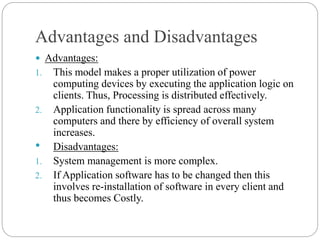Client server s/w Engineering
- 1. Sardar VallabhBhai Patel Institute Of Technology Made By: Rajan Shah Topic: Client-Server Software Engineering
- 2. What Is Client Server Software Engineering? The Client-Server architecture models the application in such a way that: 1. Server consists of a set of Services and 2. Client demands the services. The Client demands for the services provided by the Server. The Client and Server are separate processes. Example of services provided: Net Banking, e- Commerce
- 4. Client Server Architecture Client Server architecture are of two types: 1. Two-Tier Architecture 2. Three-Tier Architecture
- 5. Two-Tier Architecture In Client-Server architecture, one Server might be connected to more than one Client. In this architecture, application executes on two layer: 1. The Client Layer 2. The Server Layer • The two-tier architecture is of two types: 1. Thin-Client Model 2. Fat-Client Model
- 6. Thin-Client Model In this model the Data Management and Application Logic is implemented on the Server and the Client is responsible for running the Presentation software. Example: The Compiler makes use of thin-client model.
- 7. Advantages and Disadvantages Advantages: This model is used in Simple Applications. Disadvantages: 1. There is Heavy-Load on both the Server and the Network. The Server is responsible for all the computations which results in Heavy-Network Traffic between Client and Server. 2. As it executes only Presentation tier on the Client, it doesn’t use the power of computing devices available.
- 8. Fat-Client Model In this model, the Server is responsible only for Data Management. The Application and Presentation Software is executed on the Client Side. Example: ATM is connected to the Server. User operates the ATM’s and the information is processed at the Client side. The Data Management is handled by Server.
- 9. Advantages and Disadvantages Advantages: 1. This model makes a proper utilization of power computing devices by executing the application logic on clients. Thus, Processing is distributed effectively. 2. Application functionality is spread across many computers and there by efficiency of overall system increases. • Disadvantages: 1. System management is more complex. 2. If Application software has to be changed then this involves re-installation of software in every client and thus becomes Costly.
- 10. Three-Tier Architecture In this architecture, the Presentation, Application Processing and Data Management are logically separate processes and execute on different processors.
- 11. Example of Three-Tier Architecture Internet Banking is an example of Three-Tier Architecture. The Client browses the web page and requests for Banking Transactions (The Presentation Layer). Then the Application Processes the request and communicates with the Database Server to verify request for transaction (The Application Layer). The Database Server stores the bank database and executes queries. The Results of these queries are returned to Application Server. (Database Management Layer).
- 12. THANK YOU












